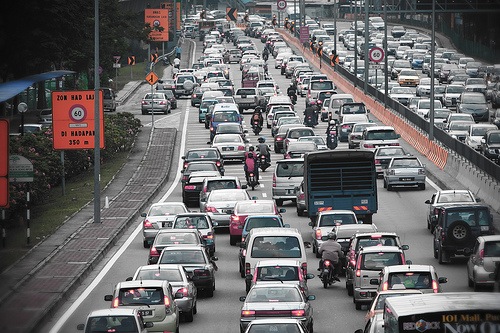 Intelligent Design
Intelligent Design
How Cellular Motors Prevent Traffic Jams

Living cells have superhighways of microtubules, crowded with molecular machines that “walk” along them delivering cargo. Sometimes things get a bit crowded, but deliveries arrive on time — thanks to a unique strategy.
In short, the machines hand off their cargo, one to the next, till it reaches the end of the traffic jam, something like the kid’s relay race game of passing a beach ball overhead down the line.
Two recent papers explain how scientists are opening the black box of intracellular transport. In PNAS, “Motor transport of self-assembled cargos in crowded environments,” four researchers in Massachusetts sought to explain “how multimotor cargos would navigate a densely crowded filament with many other motors.”
Prior theoretical and experimental biophysical model systems of intracellular cargo have assumed fixed teams of motors transporting along bare microtubules or microtubules with fixed obstacles. Here, we investigate a regime of cargos transporting along microtubules crowded with free motors.
Knowing that intracellular transport is vital for survival and that the cell is a crowded place, they were curious about how cells don’t appear to jam or dissociate. They reasoned, “motor-driven cargos must be able to circumvent traffic and crowding to efficiently deliver material throughout the cell.“
Previous research showed that teams of motors didn’t jam, but single motors would sometimes dissociate from the track. But no one had studied “the effects of high-density traffic on cargos with multiple motors.” So they attached quantum dots to kinesin motors and set them loose in an artificially high-traffic situation. To their surprise, they found a cooperative system:
Although high densities of kinesin motors hinder forward motion, resulting in a lower velocity, the ability to associate motors appears to enhance the run length and attachment time of the quantum dot, improving overall cargo transport. These results suggest that cargos that can associate new motors as they transport could overcome traffic jams.
They observed pauses and short reversals, but the teams of motors didn’t lose their cargo as easily as single motors. One strategy is the lane change:
Increasing the number of motors enables the cargo to interact with several protofilaments of the microtubule, which could enable the cargo to pass traffic on a paused protofilament. This is similar to changing lanes in a vehicular traffic jam.
Nevertheless, sometimes gridlock occurs. That’s when strategy number two comes into play: the handoff:
The work presented here explores a parameter space for intracellular traffic, specifically the activity of cargo in crowded conditions. Our artificial cargo can associate multiple motors, which aids in extending the association time and run length of the cargo at motor densities when single motors rapidly dissociate.
In one observation, they found the cargo could travel 4.5 micrometers while the kinesins stuck in traffic only moved one micrometer. The cargo appears to be handed down the line. It’s like the motor stuck behind the bumper of the next motor hands off the cargo to the driver, and so on, till the cargo arrives in front faster than the rear driver could have gotten there. Wouldn’t that be cool if truck drivers could do that!
The researchers were glad to find this out; “These results are very important for the transport of intracellular cargos that need to transport long distances in crowded spaces, especially in elongated cells, such as neurons.”
In a related subject, four researchers from the University of Pennsylvania School of Medicine, writing in Current Biology, announce that “New Tools Provide Insights into Multi-motor Transport.” Their paper begins by explaining the significance of the subject:
Many intracellular cargoes move bidirectionally along the microtubule cytoskeleton, transported by teams of kinesin and dynein motors. Kinesin drives motility towards microtubule plus ends, while dynein moves towards the minus end. The collective function of motor teams allows cargoes to move bidirectionally over large distances. This long-range transport is vital for extended, polarized cells such as neurons. Indeed, defects in microtubule motors cause neurodegenerative disease, and impaired axonal transport has been identified in models of amyotrophic lateral sclerosis, and Alzheimer’s and Huntington’s diseases. Despite its fundamental importance, an understanding of how interactions among motors on a cargo modulate their function to achieve targeted trafficking in the cell remains poorly understood.
Perhaps it’s redundant to say that an understanding remains poorly understood, but their focus was not on grammar but traffic control: how and when do cargoes get transferred from one direction to the other? Is it regulated or chaotic? Do the opposite-bound motors create a tug-of-war?
Their paper was primarily a summary of other published work, but they suggested that the motors themselves do not control the effective delivery of cargo. Those are just mechanical robots with pre-programmed specs, like how fast they can go and how much force they can exert. Researchers can artificially get them to compete, like robots battling in a tiny arena:
While artificial scaffolds move unidirectionally and are often stalled in a static tug-of-war, endogenous cargoes with opposing motors bound are motile and display frequent directional switches. Vesicles isolated from mouse brain continue to move bidirectionally along microtubules in vitro, driven by a complement of stably-bound kinesin-1, kinesin-2, and dynein motors in the absence of cytosolic factors. Quantitative analysis of active motors bound to endogenous cargoes suggests that bidirectional cargoes are driven by small teams of strong kinesin motors and large teams of relatively weak dynein motors operating at or near force balance.
Although not ready to say that transport isn’t just a factor of the mechanical properties of the motors, the team hinted that bidirectional transport requires higher levels of control:
One possible explanation for differences in the motility observed for artificial scaffolds and endogenous cargoes is that additional regulatory factors are required to reconstitute bidirectional motility. These regulatory factors may act to prevent the static tug-of-war observed for synthetic cargoes.
So while they ended by noting that more research will be required, the efficiency and effectiveness of intracellular transport appears to be a promising area for design-theoretic research. The proof of the pudding is in the eating. We can eat pudding, walk to the store to buy it, and do all the other things we do in life because of a coordinated system of molecular machines at work in each and every cell of our bodies.
So why waste research time looking for a stochastic, aimless process? When the overall picture is one of purposeful action dependent on multiple coordinated parts, each required for function, that’s the green light to go hunting for intelligent design. Prediction: a traffic control system will be found. That’s the heuristic model most likely to provide understanding.
Photo credit: Michael Loke/Flickr.

